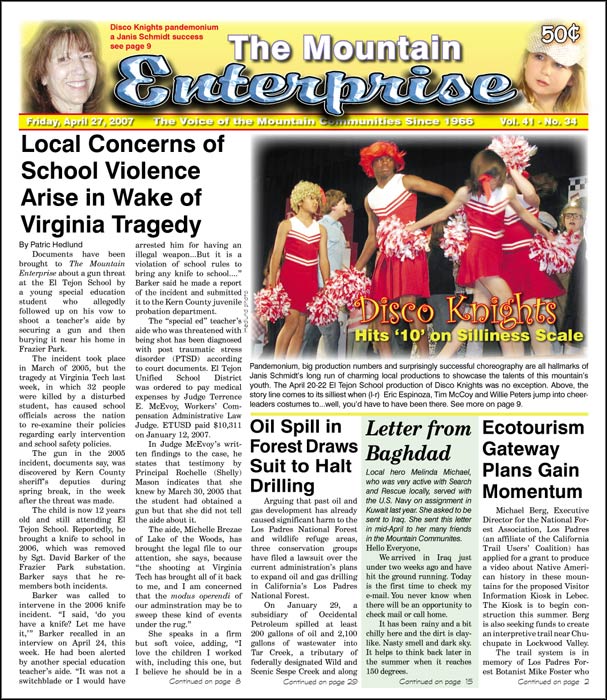Arguing that past oil and gas development has already caused significant harm
to the Los Padres National Forest and wildlife refuge areas, three conservation
groups have filed a lawsuit over the current administration’s plans to expand
oil and gas drilling in California’s Los Padres National Forest.
On January 29, a subsidiary of Occidental Petroleum spilled at least 200
gallons of oil and 2,100 gallons of wastewater into Tar Creek, a tributary of
federally designated Wild and Scenic Sespe Creek and along the southern boundary
of the Sespe Condor Sanctuary. Observers allege that 800 gallons was spilled. An
investigation is underway.
“The recent oil spill near the Sespe Condor Sanctuary in the Los Padres is
proof that oil drilling expansion is incompatible with the protection of our
wild lands,” said Kim Delfino, California program director for Defenders of
Wildlife. “If more oil drilling is allowed to occur on our public lands, spills
will inevitably become even more frequent.”
Nearly a dozen other significant spills have occurred in this area in the
past three years, the groups allege, including a major spill of 8,400 gallons of
salt water and an “unknown” amount of oil into the Four Forks Creek, another
tributary of Sespe Creek, and an additional spill in the nearby Hopper Mountain
National Wildlife Refuge?an area closed to public entry and set aside to protect
the California condor.
The lawsuit, filed by Center for Biological Diversity, Defenders of Wildlife
and Los Padres ForestWatch, states that the U.S. Forest Service’s plan to
increase drilling would harm endangered California condors, other wildlife,
plants and recreation. The groups charge that the plan is a violation of the
National Environmental Policy Act and the National Forest Management Act.
“The Forest Service’s claim that new oil and gas drilling won’t cause any
harm to condors or other wildlife insults the intelligence of every American who
values long-term conservation of our national forests over short-term profit,”
said David Hogan, conservation manager for the Center for Biological Diversity.
According to a 2004 report by the Forest Service and Michigan State
University, the Los Padres is one of the most heavily visited national forests
in the country, attracting millions of visitors from San Francisco to Los
Angeles and beyond. The study revealed that forest visitors spend an average of
$43 each day they visit. With nearly two million visitors per year, the Los
Padres is a boon to the local economy.
The Los Padres National Forest oil- and gas-leasing decision was approved by
the Forest Service in July 2005 and opens 52,075 acres of the forest in Santa
Barbara and Ventura counties to oil and gas drilling, allowing more than 4,200
acres of infrastructure on the national forest. The litigants claim this will
negatively impact wildlife, including the California condor and other endangered
species, by allowing surface drilling near the Sespe Condor Sanctuary and the
Hopper Mountain National Wildlife Refuge, “both critical to the survival and
recovery of the endangered California condor.” The decision also allows surface
drilling immediately adjacent to the Dick Smith, Chumash and Sespe wilderness
areas and slant drilling beneath the Wild and Scenic Sespe Creek and Wild and
Scenic eligible Piru Creek and Santa Paula Creek.
“The expansion of oil drilling in our local wild lands is fundamentally
incompatible with forest recreation, clean air and the protection of wildlife,”
said Jeff Kuyper, executive director of Los Padres ForestWatch, based in Santa
Barbara, who added that the concerns of the local community are protected with
the suit. “The Los Padres is far too important to risk for less than a day’s
supply of oil,” Kuyper stated.
This is part of the April 27, 2007 online edition of The Mountain Enterprise.
Have an opinion on this matter? We'd like to hear from you.


